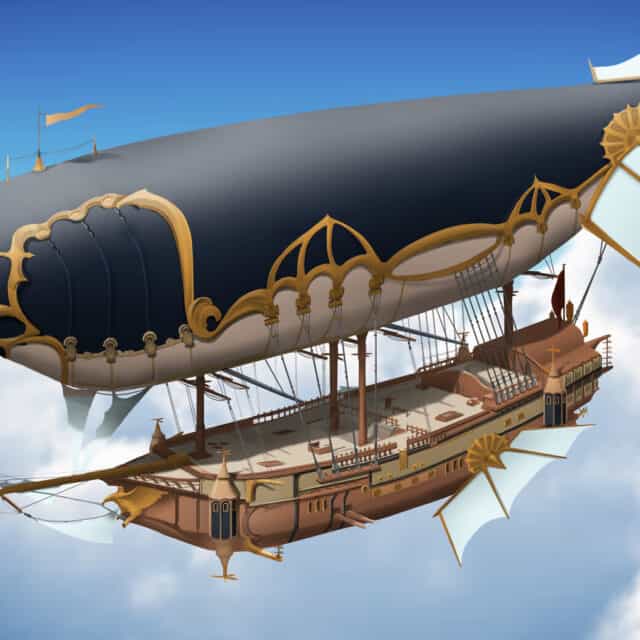The Physics of Airships

If there’s one thing that pops up in countless steampunk stories, it’s airships. Have you ever wondered about the physics of airships and how they work?
To kick things off, let’s start simple. What is the premise of ANY type of air craft? To travel through the air, duh!
But I’m talking about the OTHER premise. In steampunk-land, we’re talking about a steam powered approach to technology. A mechanically oriented culture.
A little bit of history
The Wright Brothers made their first powered flight in 1903. And it was through the following years that powered aircraft was enhanced, to the point that Sopwith Camels were seen in World War I (but weren’t REALLY a big influence)
So to back up to steampunk adventures, we must cast aside powered, fixed-wing aircraft. And that leaves us with dirigibles. Dirigibles are lighter-than-air aircraft that leverage something physics calls calls buoyancy to make flight.
A little bit of science
Buoyancy is a form of pressure. You experience it every time you climb into the bath tab or go for a swim. The mass your body exerts displaces the water around it. The only place for the water to go is away…and up. Hence the water level rises. Even if you dive into a lake, the overall height of the lake rises, albeit so little you can’t see it.
The gravity that pushes you down ALSO pushes that water down. And the water being pushed down pushes back on you. This is what’s known as a buoyant force.
All fluids exert buoyant forces. And so do gases. The air around you exerts a buoyant force as well, but not as strong. Gases have an additional property–pressure. The atomic properties of gases can ALSO cause a form pressure to emerge as a natural property.
The air around us is comprised of 78% nitrogen and 21% oxygen. The weight of this mixture of gases and its emergent pressure pushes against you and everything else.
If you capture a lighter weight gas such as helium in a flexible container like a balloon, then these two entities will push against each other. The helium will push down, but it turns out, the atomic mass of the nitrogen/oxygen carries more mass and will sink below the helium.
This should sound familiar. The buoyant force of the air will push the helium balloon out of the way, which translates upward. If there were no enclosure, the helium would rise high in the atmosphere. But the container causes this to slow until an equilibrium is reached.
A little bit of engineering
By filling up a balloon with helium (or hydrogen), you can create an aircraft that cancels out the mass of its passengers and equipment. Basically just sitting on the air, all you need is a means to push your aircraft forward. That is a way to PROPEL you forward.
Enter the propeller. Whether that propeller is turned by people or a steam powered motor is up to you. All the engineer must do is calculate the total mass of all the hardware, and they can deduce exactly how much helium is needed to cancel out all the weight and float.
A little bit of danger

No form of flight is 100% safe. In the olden days, scientists were more familiar with hydrogen given how easy it was to harvest from water and other things. Helium much more expensive in the day to harvest.
And so they would fill up huge balloons with this gas, cancel out the weight of passengers and gear, and start flying. But there was a danger. Hydrogen is the most reactive element on the entire periodic table. It will even react with anything, whereby “react” usually translates to “with flames.”
Engineers knew this, and attempted to build safety into their ships. But everyone knows about the Hindenburg, the German airship that caught fire trying to dock.
Buoyancy was lost, and the flames also reached the fuel tanks. For an aircraft that measured 245m long (2 1/2 football fields), it only took about thirty seconds to completely burn up.





Ever Wondered How Steam Power Works? • YA Steampunk
[…] stylish Victorian clothing. But also due to old time tech being carried forward in new ways. We see gadgets and communications devices that are designed to be fancier and more elegant, yet still hung upon […]